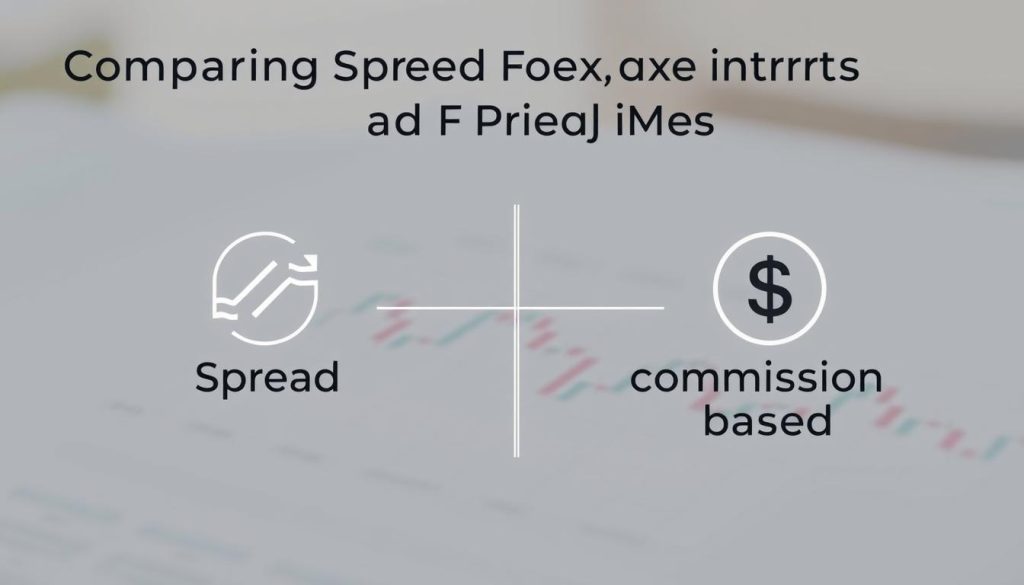Currency markets have evolved dramatically, offering new ways to reduce costs and enhance profitability. One groundbreaking development is accounts that remove traditional bid-ask spreads. This model lets traders open positions without paying the usual difference between buy and sell prices.
Active market participants, like scalpers and day traders, often benefit most from this approach. Strategies requiring frequent trades can become more profitable when transaction fees drop significantly. Even long-term investors gain advantages through improved entry and exit precision.
Understanding how these accounts work is critical for maximizing results. Brokers offering this pricing structure typically charge commissions instead of marking up spreads. Regulatory oversight remains essential to ensure fair pricing and transparent operations.
Key Takeaways
- Eliminates traditional bid-ask spreads for reduced transaction costs
- Ideal for high-frequency strategies like scalping or day trading
- Requires understanding of commission-based broker models
- Enhances profitability through precise price execution
- Demands careful broker selection based on regulation and pricing transparency
Introduction to Zero Spread Forex Trading
Market innovations now allow traders to bypass traditional pricing limitations. Specialized trading accounts eliminate the standard gap between buy and sell prices, creating a streamlined cost structure. This approach particularly benefits those executing rapid trades or precise entries.
Defining Zero Spread Accounts
These account types remove typical bid-ask differences, though temporary price gaps may occur during volatile periods. Brokers offset revenue through fixed commissions or financing fees instead of markup strategies. As one industry analyst notes:
“The true value lies not in zero costs, but in predictable pricing that aligns with specific strategies.”
Mechanics of Spread-Free Trading
Brokers aggregate liquidity from multiple sources to deliver real-time pricing. This process enables:
- Instant order execution at requested prices
- Tighter pricing during peak market hours
- Reduced slippage for high-volume traders
Successful navigation requires understanding how forex brokers balance client needs with sustainable operations. While spreads approach zero, traders should evaluate overall cost structures before committing to specific platforms.
Importance of Low Trading Costs in Forex
In competitive currency markets, every saved dollar on fees directly boosts potential returns. Trading through margin accounts amplifies both gains and expenses, making cost management crucial. Minor fees compound rapidly when using leverage, especially for active participants executing numerous daily positions.
Reducing Overall Transaction Expenses
Every commission and fee affects profitability, particularly in leveraged environments. As trading volumes grow, these expenses can erode gains that rely on small price movements. One study found that active traders allocating $50,000 capital might pay over $15,000 annually in hidden costs without optimized pricing structures.
Transaction costs directly determine required price movements for profitability. Wider spreads force traders to wait for larger market shifts—a challenge during stagnant periods. “Cutting expenses isn’t just about saving money,” notes a financial strategist. “It’s about increasing strategic flexibility in evolving markets.”
Advanced participants leverage commission-based models to sharpen their edge. Reduced fees permit tighter stop-loss orders and improved risk-reward ratios without compromising position size. For algorithmic systems processing thousands of trades daily, even 0.1 pip reductions create measurable performance differences over time.
Advantages of Zero Spread Forex Trading
Modern trading environments reward precision and cost efficiency. Accounts eliminating traditional pricing gaps create opportunities for strategies that thrive on rapid execution. These setups prove particularly valuable for participants needing to maximize small price movements.
Minimizing Trading Costs for Scalpers
High-frequency strategies gain immediate benefits from reduced transaction fees. Scalpers targeting 5-10 pip movements no longer sacrifice profits to cover spread expenses. One professional noted: “Eliminating this hurdle lets us focus purely on price action rather than cost recovery.”
Algorithmic systems show measurable improvements in zero-cost environments. Tight stop-loss orders become viable when brokers don’t widen spreads during volatility. This precision helps automated tools maintain consistent performance across hundreds of daily trades.
Key benefits include:
- Profitability from 1-2 pip fluctuations
- Reduced breakeven thresholds for rapid-fire positions
- Enhanced risk management through predictable pricing
Market openings and news events transform into prime opportunities under this model. Traders exploit momentary inefficiencies without fearing sudden cost spikes. These conditions particularly favor systems analyzing real-time technical indicators across multiple currency pairs.
Comparing Spread Forex Brokers and Pricing Models
Broker pricing structures directly impact trading outcomes. Traders must analyze how firms charge for services to avoid hidden expenses. Two primary models dominate: spread-based and commission-based accounts.

Understanding Spreads Versus Commissions
Spread forex brokers often advertise low or near-zero gaps between buy/sell prices. However, some offset this through per-trade fees. For example, CMC Markets uses spread-only pricing with competitive rates, while Interactive Brokers combines 0.19 pip EUR/USD spreads with 0.40 pip commissions.
| Broker | Spread Model | Commission | Best For |
|---|---|---|---|
| CMC Markets | Spread-only | None | Occasional traders |
| Interactive Brokers | Low spread + fee | $0.40 per trade | High-volume strategies |
Evaluating Effective Trading Costs
Total expenses depend on trade frequency and position size. A broker offering zero spreads but high fees might cost more than one with slightly wider gaps. “Always calculate costs per million traded,” advises a professional day trader.
Consider these factors:
- Overnight financing rates
- Account maintenance charges
- Currency conversion fees
High-frequency traders often prefer transparent commission structures. Casual participants may benefit from spread-only pricing’s predictability. Always verify if advertised rates apply during volatile periods.
Top Zero Spread Forex Brokers in the U.S.
Selecting the right brokerage partner significantly impacts trading outcomes. Four established platforms dominate the American landscape with optimized pricing models and regulatory compliance.
Performance Leaders in Transparent Pricing
CMC Markets sets benchmarks through its FX Active program, offering zero-pip pricing on majors with $2.50 commissions. Their Next Generation platform maintains spreads within 0.7 pips during normal sessions.
Interactive Brokers employs an agency execution model, combining 0.19 pip EUR/USD gaps with $0.40 round-turn fees. One institutional trader remarks: “Their multi-asset access lets us diversify without cost penalties.”
| Platform | EUR/USD Spread | Commission | Unique Feature |
|---|---|---|---|
| OANDA | 0.8 pips avg | None | 91/100 review score |
| FOREX.com | 0.0 pips | $7 per lot | TradingView integration |
Regulatory Safeguards for Traders
All listed brokers operate under CFTC/NFA supervision. This ensures:
- Mandatory capital adequacy requirements
- Transparent fee disclosures
- Dispute resolution mechanisms
OANDA’s 91/100 rating reflects its compliance rigor and stable spreads during news events. FOREX.com balances zero-pip accounts with platform diversity, supporting MT4/MT5 alongside proprietary solutions.
A Closer Look at Execution Speed and Trading Platforms
Trading success increasingly depends on split-second decisions and robust technology infrastructure. Modern platforms process transactions faster than ever, with top brokers executing market orders in under 100 milliseconds. This speed proves critical when capitalizing on fleeting price movements.

Comparing Popular Trading Solutions
OANDA’s platform delivers market orders in 84 milliseconds, while limit orders execute at 86 ms. This rapid processing helps traders lock in precise entry points. MetaTrader 4 remains favored for automated strategies, supporting 9,000+ custom indicators and algorithmic backtesting.
| Platform | Execution Speed | Technical Tools | Best For |
|---|---|---|---|
| MT4 | 120 ms avg | Expert Advisors | Automated systems |
| MT5 | 95 ms avg | 35+ indicators | Multi-asset analysis |
| IBKR Workstation | 75 ms avg | Sentiment analytics | Institutional strategies |
MetaTrader 5 expands capabilities with advanced order types and market depth visualization. Proprietary solutions like Interactive Brokers’ platform integrate real-time sentiment data – a game-changer for news-based strategies. As one developer notes: “Custom tools let traders spot patterns before they appear on mainstream charts.”
The Tastyfx web platform balances speed with simplicity, offering 25+ indicators for quick analysis. Traders must match platform features to their strategy – automated systems thrive on MT4, while discretionary traders often prefer proprietary interfaces with integrated analytics.
Risk Management in Zero Spread Forex Trading
Navigating financial markets requires balancing cost efficiency with operational realities. While accounts with minimal pricing gaps reduce upfront expenses, hidden costs can emerge through alternative channels. Savvy participants scrutinize fee structures and execution practices to protect their capital.
Uncovering Hidden Operational Costs
Brokers often offset lost spread revenue through overnight financing fees or withdrawal charges. A single $30 monthly maintenance fee could erase profits from 10 successful micro-lot trades. Active strategies face amplified risks from these recurring expenses.
Execution quality varies significantly between platforms. Some providers delay order processing during volatile periods, increasing slippage risks. As one markets analyst warns: “Sustainable pricing models always have clear revenue streams – transparency separates legitimate operators from questionable ones.”
Key considerations include:
- Commission structures per trade size
- Swap rates for positions held overnight
- Deposit/withdrawal processing fees
High-frequency traders report 12-15% cost reductions using brokers with fixed per-lot commissions instead of variable spreads. However, requotes occur 23% more frequently during news events with certain zero-cost providers according to recent data.
Robust risk protocols involve setting wider stop-loss margins to account for potential execution delays. Diversifying across multiple regulated brokers helps mitigate platform-specific issues. Regular fee audits ensure hidden charges don’t silently erode profitability over time.
Strategies for Scalping and High-Frequency Trading on Zero Spread Accounts
Financial markets move at lightning speed, demanding strategies that exploit micro-movements. Accounts with minimal pricing gaps enable professionals to execute hundreds of trades daily without cost barriers. These conditions favor participants who combine technical precision with robust infrastructure.
Optimizing Execution in Fast Markets
Successful scalpers rely on market orders with instant fills and stop-loss tools anchored to key support/resistance zones. One algorithmic developer states: “Latency under 50 milliseconds separates profitable systems from obsolete ones.” Platforms like cTrader and MetaTrader excel here, offering automated solutions that react faster than manual trading.
IC Markets’ Raw Spread Account exemplifies this approach. Their model pairs tight pricing with $3.50 commissions per lot, attracting systematic traders. Key advantages include:
- Access to 12 liquidity providers for competitive pricing
- 85% faster order processing than industry averages
- Integration with third-party algorithmic tools
High-frequency systems thrive by exploiting 0.3-pip discrepancies across EUR/USD and GBP/JPY pairs. These strategies require brokers with direct market access to avoid processing delays during news events. As volatility spikes, robust platforms maintain execution quality while less-equipped competitors falter.
Educational and Analytical Tools Offered by Brokers
Brokers now equip traders with sophisticated resources to sharpen decision-making. Leading platforms integrate learning modules with real-time data analysis, creating seamless skill development environments. These systems help users identify opportunities while managing risks.
Utilizing Advanced Charting and Technical Analysis
Modern trading tools transform raw data into actionable insights. Platforms like TradingView and MetaTrader 5 offer 100+ technical indicators, from moving averages to Fibonacci retracements. One algorithmic developer notes: “Custom indicators let traders spot patterns invisible to basic chart setups.”
Multi-timeframe analysis tools reveal hidden market dynamics. Traders overlay economic calendars on price charts to correlate news events with volatility. Heatmaps and volume profiles highlight concentration zones where major players operate.
Key features include:
- Backtesting capabilities for strategy validation
- Customizable alert systems for price thresholds
- Pattern recognition engines identifying classic formations
Top-tier brokers provide video tutorials explaining complex concepts like Elliott Wave theory. Interactive webinars demonstrate how professionals combine these tools for consistent results. This educational support helps traders transition from theoretical knowledge to practical execution.
FAQ
How do zero spread accounts reduce transaction costs?
These accounts eliminate the bid-ask markup, replacing it with a fixed commission. This structure benefits active traders by lowering per-trade expenses, particularly for strategies involving frequent entries and exits.
Why is execution speed critical for scalpers using spread-free models?
Fast order processing ensures traders capitalize on micro-price movements. Delays of even milliseconds can erode profits in high-frequency strategies, making robust platforms like MT5 or broker-specific systems essential.
What hidden fees should traders monitor with commission-based pricing?
While upfront spreads disappear, costs like overnight financing charges, inactivity fees, or currency conversion markups can accumulate. Reputable brokers like Interactive Brokers disclose these transparently in fee schedules.
How do U.S. regulations impact spread-free brokerage offerings?
The CFTC and NFA enforce strict leverage caps (e.g., 50:1 for major pairs) and require negative balance protection. These rules ensure brokers like CMC Markets maintain segregated client funds and fair pricing practices.
Which technical tools enhance analysis for low-cost trading strategies?
Platforms offering real-time depth-of-market data, customizable indicators, and algorithmic scripting (e.g., MetaTrader’s MQL5) help traders identify short-term opportunities while managing risk exposure effectively.
Can commission-based models outperform traditional spread pricing for swing traders?
For positions held longer than one day, the math shifts. Swing traders might prefer slightly wider spreads if they avoid overnight financing costs, highlighting the need to compare total cost scenarios.
What order types optimize high-frequency strategies on these accounts?
Immediate-or-cancel (IOC) and fill-or-kill (FOK) orders prevent partial executions, while stop-limit entries help control slippage during volatile market events—critical when targeting narrow profit margins.
